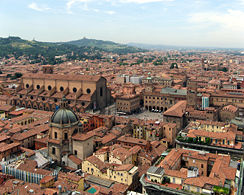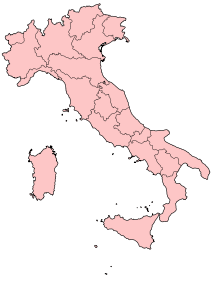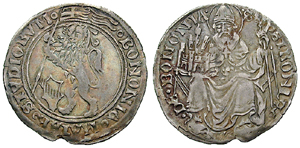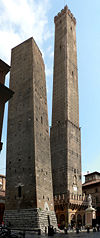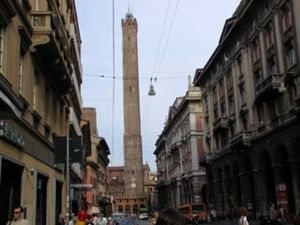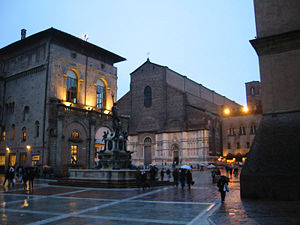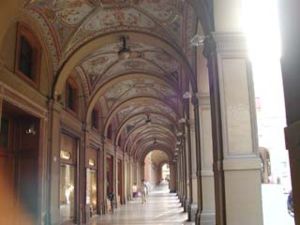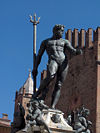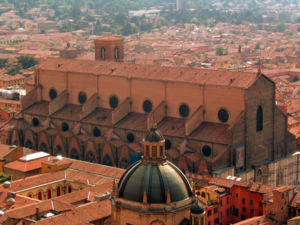Bologna
2008/9 Schools Wikipedia Selection. Related subjects: Europe; European Cities
| Comunita di Bologna | |
|---|---|
 Municipal coat of arms |
|
|
|
|
| Country | |
| Region | Emilia-Romagna |
| Province | Bologna (BO) |
| Mayor | Sergio Cofferati |
| Elevation | 54 m (177 ft) |
| Area | 140.73 km² (54 sq mi) |
| Population (as of 2007- 05-31) | |
| - Total | 373,170 |
| - Density | 2,652/km² (6,869/sq mi) |
| Time zone | CET, UTC+1 |
| Coordinates | |
| Gentilic | Bolognesi |
| Dialing code | 051 |
| Postal code | 40100 |
| Frazioni | Frabazza, Paderno, Rigosa, Monte Donato |
| Patron | St. Petronius |
| - Day | October 4 |
| Website: http://www.comune.bologna.it/ | |
Bologna (pronounced [boloɲa], from Latin Bononia, Bulåggna in Bolognese dialect) is the capital city of Emilia-Romagna in northern Italy, in the Po Valley ( Pianura Padana in Italian), between the Po River and the Apennines, exactly between the Reno River and the Sàvena River. Home of the oldest university in the Western world, "Alma Mater Studiorum", founded in 1088, Bologna is one of the most developed cities in Italy. Bologna ranks often as one of the top cities related to quality of life in Italy. This is due to its strong industrial tradition and physical position--located at the crossing of the most important highways and railways in the country--as well as its wide range of highly-developed social services.
History
Bologna was founded by the Etruscans with the name Felsina ( c. 534 BCE) in an area previously inhabited by the Villanovians, a people of farmers and shepherds. The Etruscan city grew around a sanctuary built on a hill, and was surrounded by a necropolis.
In the 4th century BC, the city was conquered by the Boii, a Gallic tribe, from which came the ancient name Bononia of the Roman colony founded in c.189 BC. The settlers included three thousand Latin families led by the consuls Lucius Valerius Flaccus, Marcus Atilius Seranus, and Lucius Valerius Tappo. The building of the Via Aemilia in 187 BC made Bologna a road hub, connected to Arezzo through the Via Flaminia minor and to Aquileia through the Via Aemilia Altinate.
In 88 BC, the city became a municipium: it had a rectilinear street plan with six cardi and eight decumani (intersecting streets) which are still discernible today. During the Roman era, its population varied between c. 12,000 to c. 30,000. At its peak, it was the second city of Italy, and one of the most important of all the Empire, with various temples and baths, a theatre, and an arena. Pomponius Mela included Bononia among the five opulentissimae ("richest") cities of Italy. Although fire damaged the city during the reign of Claudius, the Roman Emperor Nero rebuilt it in the first century AD.
After a long decline, Bologna was reborn in the fifth century under bishop Petronius, who traditionally built the church of S. Stefano. After the fall of Rome, Bologna was a frontier stronghold of the Exarchate of Ravenna in the Po plain, and was defended by a line of walls which however did not enclose most of the ancient ruined Roman city. In 728, the city was captured by the Lombard king Liutprand, becoming part of the Lombard Kingdom. The Germanic conquerors formed a district called "addizione longobarda" near the complex of S. Stefano, where Charlemagne stayed in 786.
In the 11th century, Bologna began to grow again as a free commune, joining the Lombard League against Frederick Barbarossa in 1164. In 1088, the Studio was founded, now the oldest university in Europe, which could boast notable scholars of the Middle Ages like Irnerius, and, among its students, Dante, Boccaccio and Petrarca. In the twelfth century, the expanding city needed a new line of walls, and another was completed in the fourteenth century.
In 1256, Bologna promulgated the Legge del Paradiso ("Paradise Law"), which abolished feudal serfdom and freed the slaves using public money. At that time the city centre was full of towers (perhaps 180), built by the leading families, notable public edifices, churches, and abbeys. In the 1270s Bolognese politics was dominated by the lettered Luchetto Gattilusio who served as podestà. Like most Italian cities of that age, Bologna was torn by internal struggles related to the Guelph and Ghibelline factions, which led to the expulsion of the Ghibelline family of the Lambertazzi in 1274.
In 1294, Bologna was perhaps the fifth or sixth largest city in Europe, after Cordoba, Paris, Venice, Florence, and, probably, Milan, with 60,000 to 70,000 inhabitants. After being crushed in the Battle of Zappolino by the Modenese in 1325, Bologna began to decay and asked the protection of the Pope at the beginning of the fourteenth century. In 1348, during the Black Plague, about 30,000 inhabitants died.
After the happy years of the rule of Taddeo Pepoli (1337-1347), Bologna fell to the Visconti of Milan, but returned to the Papal orbit with Cardinal Gil de Albornoz in 1360. The following years saw an alternation of Republican governments like that of 1377, which was responsible for the building of the Basilica di San Petronio and the Loggia dei Mercanti, and Papal or Visconti restorations, while the city's families engaged in continual internecine fighting. In the middle of the fifteenth century, the Bentivoglio family gained the rule of Bologna, reigning with Sante (1445-1462) and Giovanni II (1462-1506). This period was a flourishing one for the city, with the presence of notable architects and painters who made Bologna a true city of art. During the Renaissance, Bologna was the only Italian city that allowed women to excel in any profession. Women there had much more freedom than in other Italian cities; some even had the opportunity to earn a degree at the university.
Giovanni's reign ended in 1506 when the Papal troops of Julius II besieged Bologna and sacked the artistic treasures of his palace. From that point on, until the eighteenth century, Bologna was part of the Papal States, ruled by a cardinal legato and by a Senate which every two months elected a gonfaloniere (judge), assisted by eight elder consuls. In 1530, in front of Saint Petronio Church, Charles V was crowned Holy Roman Emperor by Pope Clement VII.
The city's prosperity continued, although a plague at the end of the sixteenth century reduced the population from 72,000 to 59,000, and another in 1630 to 47,000. The population later recovered to a stable 60,000-65,000. In 1564, the Piazza del Nettuno and the Palazzo dei Banchi were built, along with the Archiginnasio, the seat of the University. The period of Papal rule saw the construction of many churches and other religious establishments, and the renovation of older ones. Bologna had ninety-six convents, more than any other Italian city. Artists working in this age in Bologna established the Bolognese School that includes Annibale Carracci, Domenichino, Guercino and others of European fame.
With the rise of Napoleon, Bologna became the capital of the Repubblica Cispadana and, later, the second most important centre after Milan of the Repubblica Cisalpina and the Italian Kingdom. After the fall of Napoleon, Bologna suffered the Papal restoration, rebelling in 1831 and again 1849, when it temporarily expelled the Austrian garrisons which commanded the city until 1860. After a visit by Pope Pius IX in 1857, the city voted for annexation to the Kingdom of Sardinia on June 12, 1859, becoming part of the united Italy.
In the new political situation, Bologna gained importance for its cultural role and became an important commercial, industrial, and communications hub; its population began to grow again and at the beginning of the twentieth century the old walls were destroyed (except for a few remaining sections) in order to build new houses for the population.
On August 2, 1980, a massive bomb killed 86 people in the central train station in the city (see Bologna massacre). Only two months previously, Aerolinee Itavia Flight 870 had crashed under suspicious circumstances.
Importance
Bologna is a very important railway and motorway hub in Italy. The city's Fiera District (exhibition area) is the second largest in Italy and the fourth largest in Europe, with important international exhibitions, like the motorshow , Saie, Saiedue and Cersaie (buildings), Cosmoprof (beauty culture, considered the most important in the world), Lineapelle, etc. Bologna and its metropolitan area have several important industries in the fields of mechanics, foods, and electronics, important retail and wholesale trade (the "Centergross" in the northern metropolitan area, built in 1973, was the largest in Europe for several years), and the first Italian vegetable and fruit market.
Bologna has about 400,000 inhabitants in the city proper and about 1 million in the metropolitan area, including over 100,000 students of the ancient and renowned University of Bologna, founded in the eleventh century.
Main sights
Until the early nineteenth century, when a large-scale urban reconstruction project was undertaken, Bologna remained one of the best-preserved medieval cities in Europe; to this day it remains unique in its historic value. Despite having suffered considerable bombing damage in 1944, Bologna's historic centre, Europe's second largest (after Venice), contains a wealth of important Medieval, Renaissance, and Baroque artistic monuments.
Bologna developed along the Via Emilia as an Etruscan and later Roman colony; the Via Emilia still runs straight through the city under the changing names of Strada Maggiore, Rizzoli, Ugo Bassi, and San Felice. Due to its Roman heritage, the central streets of Bologna, today largely pedestrianized, follow the grid pattern of the Roman settlement.
The original Roman ramparts were supplanted by a high medieval system of fortifications, remains of which are still visible, and finally by a third and final set of ramparts built in the thirteenth century, of which numerous sections survive. Over twenty medieval defensive towers, some of them leaning precariously, remain from the over two hundred that were constructed in the era preceding the security guaranteed by unified civic government. For a complete treatment, see Towers of Bologna.
Bologna is home to numerous important churches. An incomplete list includes:
- the basilica of San Petronio, one of the biggest in the world (during construction it was intended to be larger than St. Peter's in Rome, but Pope Pius IV ordered that the arms of the church be truncated, leaving it without transepts).
- San Pietro Cathedral
- Santo Stefano basilica and sanctuary
- San Domenico basilica and sanctuary
- San Francesco basilica
- Santa Maria dei Servi basilica
- San Giacomo Maggiore basilica
- Sanctuary of the Madonna di San Luca (basilica) on Colle della Guardia
- San Michele in Bosco
- San Paolo the Great, basilica
The cityscape is further enriched by elegant and extensive arcades (or porticos), for which the city is famous. In total, there are some 38 kilometres of arcades in the city's historical centre (over 45 km in the city proper), which make it possible to walk for long distances sheltered from rain, snow, or hot summer sun. The Portico of San Luca, the longest in the world (3.5 km, 666 arcades) connects the Porta Saragozza (one of the twelve gates of the ancient walls built in the Middle Ages, which circled a 7.5 km part of the city) with the San Luca Sanctuary, on Colle della Guardia, over the city (289 m.).
The Sanctuary of the Madonna di San Luca is located just outside the main city on the Colle della Guardia (Guard Hill). Built in the eleventh century, it was much enlarged in the fourteenth and eighteenth centuries. The interior contains works of several masters, but probably the most important is the painting of the Madonna with Child attributed to Luke the Evangelist. The best way to visit this Sanctuary is on foot; you can walk under the portico mentioned above.
Culture
Over the centuries, Bologna has acquired many nicknames: "the learned one" (la dotta) is a reference to its famous university; "the fat one" (la grassa) refers to its cuisine.
"The red one" (la rossa) originally refers to the colour of the roofs in the historic centre, but this nickname is also connected to the political situation in the city, started after World War II: until the election of a centre-right mayor in 1999, the city was renowned as a bastion of socialism and communism. The centre-left regained power again in the 2004 mayoral elections, with the election of Sergio Cofferati. It was one of the first European towns to experiment with the concept of free public transport.
Another nickname for Bologna is the Basket City, referring to Bologna's obsession with basketball, which is partly unusual in football-dominated Italy. The local derby between the city's two principal basketball clubs, Fortitudo and Virtus (often called after the clubs' principal sponsors), is intense, as you can see here and here.
Football is still a highly popular sport in Bologna; the main local club is Bologna F.C. 1909, which is currently in the national Serie B.
The city of Bologna was appointed a UNESCO City of Music on 29 May 2006. According to UNESCO, "As the first Italian city to be appointed to the Network, Bologna has demonstrated a rich musical tradition that is continuing to evolve as a vibrant factor of contemporary life and creation. It has also shown a strong commitment to promoting music as an important vehicle for inclusion in the fight against racism and in an effort to encourage economic and social development. Fostering a wide range of genres from classical to electronic, jazz, folk and opera, Bologna offers its citizens a musical vitality that deeply infiltrates the city’s professional, academic, social and cultural facets."
Transport
Bologna is home to Guglielmo Marconi International Airport, expanded in 2004 by extending the runway to accommodate larger aircraft. It is the fifth busiest Italian airport for passenger traffic (over than 4 million/year in 2006). Since 2004, it is also the third busiest for intercontinental flights.
Bologna Central Station is considered the most important train hub in Italy thanks to the city's strategic location. Also, its goods-station (San Donato) with its 33 railway tracks, is the largest in Italy in size and traffic.
Bologna's station holds a memory in Italian public consciousness of the terrorist bomb attack that killed 85 victims in August 1980. The attack is also known in Italy as the Strage di Bologna ("Bologna massacre").
Demographics
In May 2007 the comune of Bologna had a population of 373,170, making it the 7th largest city in Italy. As of 2004, the greater Bologna area had a resident population of 943,983, of which 94.09% were ethnic Italians. Immigrants in the city constitute 5.91% of the population. Of the 55,840 immigrants in Bologna, non-Italian Europeans number 19,668 and are chiefly of Romanian, Albanian, and Ukrainian origins. Closely following, Africans number 19,060, almost entirely North African Arabs. A recent and growing Asian population numbers 14,119 and are mostly Filipino, with some Chinese. The remaining consists of immigrants from the Americas and the Middle East. While aging continues to be a factor in the city's population, the number of births has risen in the past decade, contributing to the positive growth of the city.
- Age profile
- 00 - 14 (108,422) = 11.48%
- 15 - 64 (615,488) = 61.59%
- 65+ (220,113) = 23.31%
Cuisine
Bologna is renowned for its culinary tradition. It has given its name to the well-known Bolognese sauce, a meat based pasta sauce called in Italy ragù alla bolognese but in the city itself just ragù as in Tagliatelle al ragù.
Situated in the fertile Po River Valley, the rich local cuisine depends heavily on meats and cheeses. As in all of Emilia-Romagna, the production of cured pork meats such as prosciutto, mortadella and salame is an important part of the local food industry. Well-regarded nearby vineyards include Pignoletto dei Colli Bolognesi, Lambrusco di Modena and Sangiovese di Romagna.
Tagliatelle al ragù, lasagne, tortellini served in broth and mortadella, the original Bologna sausage, are among the local specialties.
University
The University of Bologna, founded in 1088, is the oldest existing university in Europe, and was an important centre of European intellectual life during the Middle Ages, attracting scholars from throughout Christendom. A unique heritage of medieval art, exemplified by the illuminated manuscripts and jurists' tombs produced in the city from the thirteenth to the fifteenth century, provides a cultural backdrop to the renown of the medieval institution. The Studium, as it was originally known, began as a loosely organized teaching system with each master collecting fees from students on an individual basis. The location of the early University was thus spread throughout the city, with various colleges being founded to support students of a specific nationality.
In the Napoleonic era, the headquarters of the university were moved to their present location on Via Zamboni (formerly Via San Donato), in the north-eastern sector of the city centre. Today, the University's 23 faculties, 68 departments, and 93 libraries are spread across the city and include four subsidiary campuses in nearby Cesena, Forlì, Ravenna, and Rimini. Noteworthy students present at the university in centuries past included Dante, Petrarch, Thomas Becket, Pope Nicholas V, Erasmus of Rotterdam, Peter Martyr Vermigli, and Copernicus. Laura Bassi, appointed in 1732, became the first woman to officially teach at a college in Europe. In more recent history, Luigi Galvani, the discoverer of biological electricity, and Guglielmo Marconi, the pioneer of radio technology, also worked at the University. The University of Bologna remains one of the most respected and dynamic post-secondary educational institutions in Italy. To this day, Bologna is still very much a university town, and the city's population swells from 400,000 to over 500,000 whenever classes are in session. This community includes a great number of Erasmus, Socrates, and overseas students.
The university's botanical garden, the Orto Botanico dell'Università di Bologna, was established in 1568; it is the fourth-oldest in Europe.
Famous natives of Bologna and environs
- Pupi Avati (director, born 1938)
- Adriano Banchieri (composer, 1568 – 1634)
- Agostino Barelli (architect, 1627 - 1687)
- Laura Bassi (scientist, first female appointed to university chair in Europe, 1711 – 1788)
- Ugo Bassi (Italian nationalist hero, executed for role in 1848 uprisings, 1800 - 1849)
- Stefano Benni (writer, born 1947)
- Benedict XIV (Prospero Lambertini, Pope 1740-58)
- Giovanni II Bentivoglio (1443-1508)
- Giordano Berti (writer, born 1959)
- Rossano Brazzi (actor, 1916-1994)
- Annibale Carracci (painter, 1560 – 1609)
- Lodovico Carracci (painter, 1555 – 1619)
- Agostino Carracci (painter, 1557 – 1602)
- Pierluigi Collina (football referee, born 1960)
- Scipione del Ferro (mathematician, solved the cubic equation, 1465 – 1526)
- Lucio Dalla (singer-songwriter, born 1943)
- Domenichino (Domenico Zampieri, painter, 1581 - 1641)
- Gianfranco Fini (politician, born 1952)
- Alessandro Gamberini, Italian footballer
- Luigi Galvani (scientist, discoverer of bioelectricity, 1737 – 1798)
- Serena Grandi (actress, born 1958)
- Gregory XIII (Ugo Boncompagni, Pope 1572-85, instituted Gregorian Calendar)
- Gregory XV (Alessandro Ludovisi, Pope 1621-3)
- Il Guercino (Giovanni Barbieri, painter, 1591 - 1666)
- Irnerius (jurist, c.1050 - at least 1125)
- Lucius II (Gherardo Caccianemici dell'Orso, Pope 1144-5)
- Marcello Malpighi (scientist, founder of microscopic anatomy and the first histologist, 1628-1694)
- Guglielmo Marconi (engineer, pioneer of wireless telegraphy, Nobel prize for Physics, 1874 - 1937)
- Giuseppe Mezzofanti (cardinal and linguist, 1774 - 1839)
- Marco Minghetti (economist and statesman, 1818 - 1886)
- Giorgio Morandi (painter, 1890 - 1964)
- Gianni Morandi (singer, born 1944)
- Pier Paolo Pasolini (writer, poet, director, 1922 - 1975)
- Roberto Regazzi (luthier, born 1956)
- Guido Reni (painter, 1575 - 1642)
- Ottorino Respighi (composer, 1879 - 1936)
- Augusto Righi (physicist, authority on electromagnetism, 1850 - 1920)
- Carlo Ruini (equine anatomist, 1530-1598)
- Elisabetta Sirani (painter, 1638-1665)
- Alberto Tomba (skier, born 1966)
- Ondina Valla (first Italian woman Olympic gold medalist, 1916 - 2006)
- Mariele Ventre (teacher and educator, founder of Piccolo Coro dell' Antoniano choir, 1939 - 1995)
- Christian Vieri (footballer, born 1973)
- Alex Zanardi (race car driver, born 1966)
- Maria Gaetana Agnesi (mathematician, humanitarian, and linguist, 1718-1799)
In addition to the above natives, the following became associated with Bologna by long-term residence:
- Giosuè Carducci (poet and academic, Nobel Prize for Literature, born near Lucca, Tuscany, 1835 - 1907)
- Umberto Eco (writer and academic, born in Alessandria, Piedmont, 1932)
- Giovanni Pascoli (poet and academic, born in San Mauro di Romagna, 1855 - 1912)
- St. Petronius (San Petronio, bishop of Bologna and patron saint of the city, birthplace unknown, died c. 450 AD)
- Romano Prodi (economist, politician, born in Scandiano, Reggio Emilia, 1939)
- Gioachino Rossini (opera composer, born in Pesaro, 1792 - 1868)
- Giuseppe Torelli (composer, born in Verona, 1658 - 1709)
Famous companies
- Ducati Motor Holding (motorcycles)
- Malaguti (motorcycles)
- Lamborghini (cars)
- Maserati (cars)
- A number of prominent co-operative enterprises, including Coop, the leading Italian retailing chain.
Twin cities
 Coventry, United Kingdom, since 1984
Coventry, United Kingdom, since 1984 Kharkiv, Ukraine, since 1966
Kharkiv, Ukraine, since 1966 La Plata, Argentina, since 1988
La Plata, Argentina, since 1988 Leipzig, Germany, since 1962
Leipzig, Germany, since 1962 St. Louis, Missouri, United States, since 1987
St. Louis, Missouri, United States, since 1987 Portland, Oregon, United States, since 2003
Portland, Oregon, United States, since 2003 Thessaloniki, Greece, since 1981
Thessaloniki, Greece, since 1981 San Carlos, Nicaragua, since 1988
San Carlos, Nicaragua, since 1988 Saint-Louis, Senegal, since 1991
Saint-Louis, Senegal, since 1991 Toulouse, France, since 1981
Toulouse, France, since 1981 Tuzla, Bosnia and Herzegovina, since 1994
Tuzla, Bosnia and Herzegovina, since 1994 Valencia, Spain, since 1976
Valencia, Spain, since 1976 Zagreb, Croatia, since 1963
Zagreb, Croatia, since 1963
